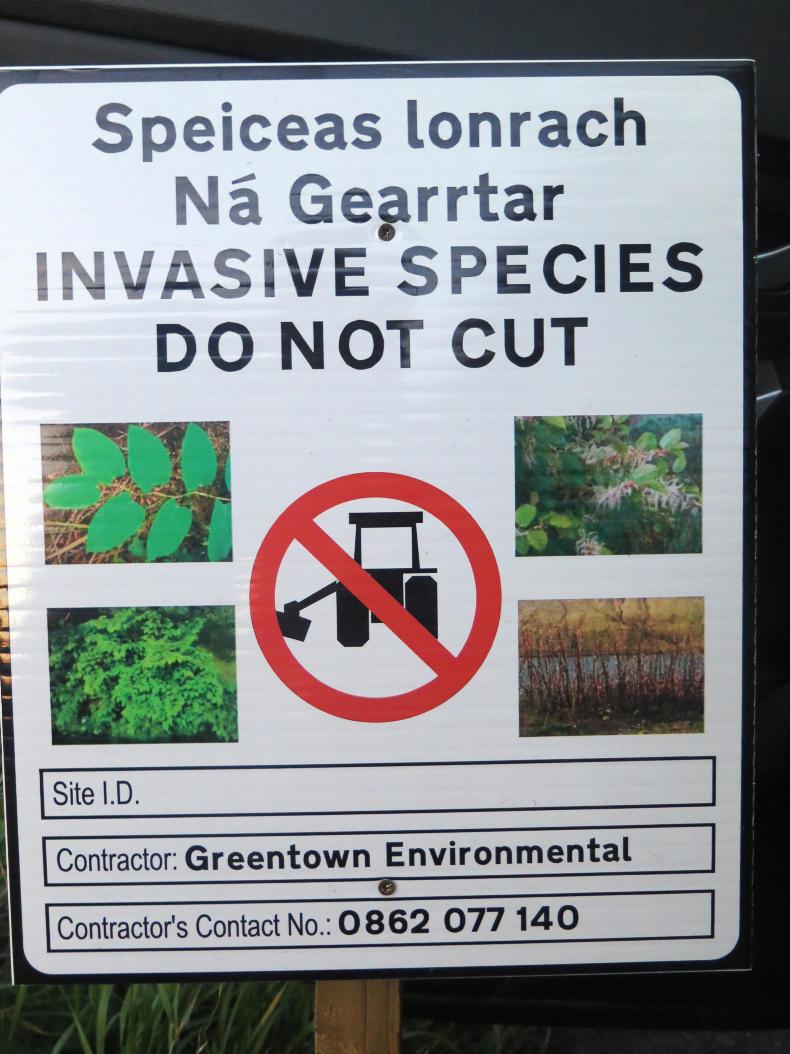The impact of knotweed on farmer’s lands can be extensive. Not pnly can it reduce land price, but it can also affect planning permission and mortgages.
With help from the National Biodiversity Data Centre, here is some advice on how to identify Japanese knotweed.
What does Japanese knotweed look like?
It is a green shrub with bamboo-like hollow stems that grows to three metres in height and forms dense stands during the summer.
Spring
In spring, small, red buds appear that develop into asparagus tip-shaped stems. As it grows, it has a green stem with red/purple flecks. Leaves are arranged in a zig-zag pattern on the stem. Summer
Clusters of small, creamy-white flowers emerge in late summer. Winter
In winter, the plant dies back, leaving dead, brown cane-like stems, either still standing or lying on the ground. Often, there is still evidence of browned flowers on stems. 
Underground
Underground, it has an extensive rhizome (which is essentially an underground stem) system, commonly with an orange centre that snaps easily, like a carrot when bent.Can Japanese knotweed or the other invasive knotweed species be confused with any other plant in Ireland?
Due to its bamboo-like stems and dense growth it is sometimes confused with bamboo plants or Red dog osier (Cornus sericea).
These other plants are, however, rarely encountered outside of areas where they have been planted and the shape of the leaf and zig-zag leaf arrangement on the stems will distinguish Japanese knotweed from these species.

Online Identification resources
• National Biodiversity Data Centre.
• GB Non-native Species Secretariat.
• Invasive Species Ireland.
Read more
Japanese knotweed threat to farm payments
Japanese knotweed plights begins to hit agriculture
The impact of knotweed on farmer’s lands can be extensive. Not pnly can it reduce land price, but it can also affect planning permission and mortgages.
With help from the National Biodiversity Data Centre, here is some advice on how to identify Japanese knotweed.
What does Japanese knotweed look like?
It is a green shrub with bamboo-like hollow stems that grows to three metres in height and forms dense stands during the summer.
Spring
In spring, small, red buds appear that develop into asparagus tip-shaped stems. As it grows, it has a green stem with red/purple flecks. Leaves are arranged in a zig-zag pattern on the stem. Summer
Clusters of small, creamy-white flowers emerge in late summer. Winter
In winter, the plant dies back, leaving dead, brown cane-like stems, either still standing or lying on the ground. Often, there is still evidence of browned flowers on stems. 
Underground
Underground, it has an extensive rhizome (which is essentially an underground stem) system, commonly with an orange centre that snaps easily, like a carrot when bent.Can Japanese knotweed or the other invasive knotweed species be confused with any other plant in Ireland?
Due to its bamboo-like stems and dense growth it is sometimes confused with bamboo plants or Red dog osier (Cornus sericea).
These other plants are, however, rarely encountered outside of areas where they have been planted and the shape of the leaf and zig-zag leaf arrangement on the stems will distinguish Japanese knotweed from these species.

Online Identification resources
• National Biodiversity Data Centre.
• GB Non-native Species Secretariat.
• Invasive Species Ireland.
Read more
Japanese knotweed threat to farm payments
Japanese knotweed plights begins to hit agriculture








 This is a subscriber-only article
This is a subscriber-only article










SHARING OPTIONS: